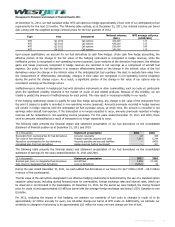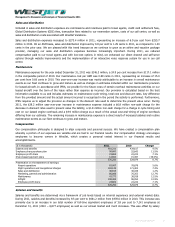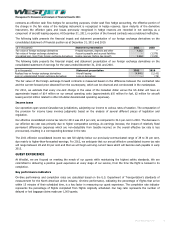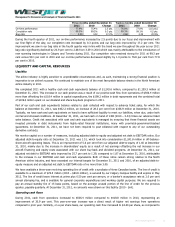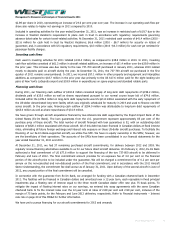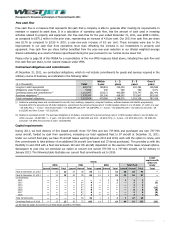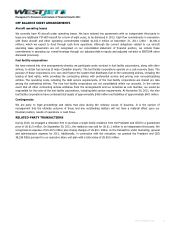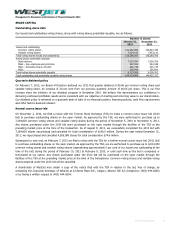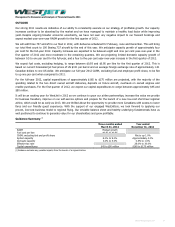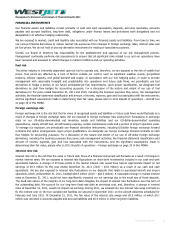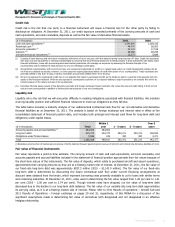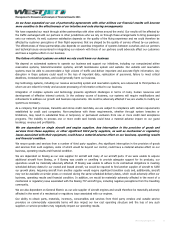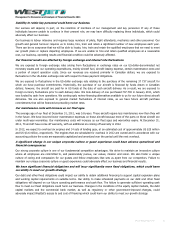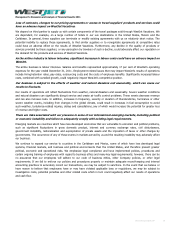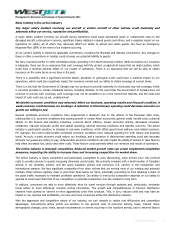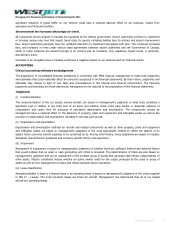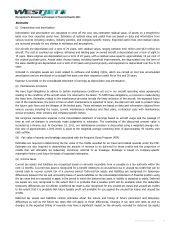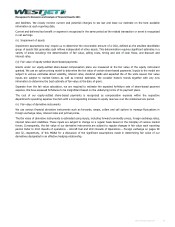Westjet 2011 Annual Report Download - page 40
Download and view the complete annual report
Please find page 40 of the 2011 Westjet annual report below. You can navigate through the pages in the report by either clicking on the pages listed below, or by using the keyword search tool below to find specific information within the annual report.
Management’s Discussion and Analysis of Financial Results 2011
│
FINANCIAL INSTRUMENTS
Our financial assets and liabilities consist primarily of cash and cash equivalents, deposits, accounts receivable, accounts
payable and accrued liabilities, long-term debt, obligations under finance leases and derivatives both designated and not
designated in an effective hedging relationship.
We are exposed to market, credit and liquidity risks associated with our financial assets and liabilities. From time to time, we
use various financial derivatives to reduce market risk exposures from changes in foreign exchange rates, interest rates and
jet fuel prices. We do not hold or use any derivative instruments for trading or speculative purposes.
Overall, our Board of Directors has responsibility for the establishment and approval of our risk management policies.
Management continually performs risk assessments to ensure that all significant risks related to us and our operations have
been reviewed and assessed to reflect changes in market conditions and our operating activities.
Fuel risk
The airline industry is inherently dependent upon jet fuel to operate and, therefore, we are exposed to the risk of volatile fuel
prices. Fuel prices are affected by a host of factors outside our control, such as significant weather events, geopolitical
tensions, refinery capacity, and global demand and supply. In accordance with our fuel hedging policy, in order to provide
management with reasonable foresight and predictability into operations and future cash flows, we periodically use fuel
derivatives to hedge a portion of our future anticipated jet fuel requirements. Upon proper qualification, we designate fuel
derivatives as cash flow hedges for accounting purposes. For a discussion of the nature and extent of our use of fuel
derivatives for the years ended December 31, 2011 and 2010, including the business purposes they serve; risk management
activities; the financial statement classification and amount of income, expense, gain and loss associated with the instruments;
and the significant assumptions made in determining their fair value, please refer to 2011 Results of operations – Aircraft fuel
on page 29 of this MD&A.
Foreign exchange risk
Foreign exchange risk is the risk that the fair value of recognized assets and liabilities or future cash flows would fluctuate as a
result of changes in foreign exchange rates. We are exposed to foreign exchange risks arising from fluctuations in exchange
rates on our US-dollar-denominated net monetary assets and liabilities and our US-dollar-denominated operating
expenditures, mainly aircraft fuel, aircraft leasing expense, certain maintenance costs and a portion of airport operation costs.
To manage our exposure, we periodically use financial derivative instruments, including US-dollar foreign exchange forward
contracts and option arrangements. Upon proper qualification, we designate our foreign exchange forward contracts as cash
flow hedges for accounting purposes. For a discussion of the nature and extent of our use of US-dollar foreign exchange
derivatives, including the business purposes they serve; risk management activities; the financial statement classification and
amount of income, expense, gain and loss associated with the instruments; and the significant assumptions made in
determining their fair value, please refer to 2011 Results of operations – Foreign exchange on page 32 of this MD&A.
Interest rate risk
Interest rate risk is the risk that the value or future cash flows of a financial instrument will fluctuate as a result of changes in
market interest rates. We are exposed to interest rate fluctuations on short-term investments included in our cash and cash
equivalents balance. A change of 50 basis points in the market interest rate would have had an approximate impact on net
earnings of $4.4 million for the year ended December 31, 2011 (2010 – $3.8 million) as a result of our cash and cash
equivalents. We are also exposed to interest rate fluctuations on our deposits that relate to purchased aircraft and airport
operations which, at December 31, 2011, totalled $28.4 million (2010 – $28.3 million). A reasonable change in market interest
rates at December 31, 2011, would not have significantly impacted our net earnings due to the small size of these deposits.
The fixed-rate nature of the majority of our long-term debt mitigates the impact of interest rate fluctuations over the term of
the outstanding debt. We account for our long-term fixed-rate debt at amortized cost, and, therefore, a change in interest
rates at December 31, 2011, would not impact net earnings. During 2011, we entered into two interest rate swap contracts to
fix the interest rate on the two variable-rate facilities we secured in December 2011 on the aircraft deliveries scheduled for
February and June 2012. At December 31, 2011, the fair value of the interest rate swaps was $0.5 million, of which $0.1
million was recorded in accounts payable and accrued liabilities and $0.4 million in other long-term liabilities.
WestJet Annual Report 2011 40


